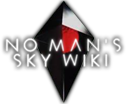| The subject of this article is from the Crossplay update.
The information from this article is up-to-date as of 16 July, 2020. |
The information from this article is is up-to-date as of 16 July, 2020.
| This article was catalogued by the Galactic Hub. |
| New Lennon | |
|---|---|

| |
| Galaxy | Euclid |
| Region | Savenix Instability |
| Star system | HUB10-6A Quetzalcoatl's Sun |
| Atmosphere | Hazy, Pink |
| Terrain | Topographically-diverse Islands |
| Biome | Lush - Viridescent |
| Weather | Mild Rain |
| Resources | AP C C+ Co Cr Cu D* Fe Fe+ H Jn Ke Bu Na Na+ NaCl O2 Pf Pg Sb SV VC |
| Sentinels | Typical |
| Flora | High |
| Fauna | Rich |
| Discovered by | Master_Xeno |
| Discovery platform | PS4 |
| Game Mode | Normal |
| Updated | Crossplay |
New Lennon is a planet in No Man's Sky.
Summary[ | ]
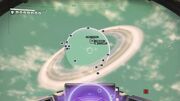
Early example of the multiple settlements on this planet. Base visibility comes and goes with server stability.
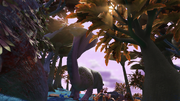
R. Musiretioe (Jade Hood Diplo) in a forest.
New Lennon is a planet in the star system HUB10-6A Quetzalcoatl's Sun in the No Man's Sky universe.
New Lennon is a ringed tropical / lush world which features the 6.0m Rangifae / diplo species R. Musiretioe, two species of large Cycromys birds, perfect weather, clear blue water, "fungal lush" trees, and diverse topography (perfectly flat islands, mountainous islands of varying sizes, underwater tunnels, and more).
History as a Former Capital Planet[ | ]
New Lennon served as the capital planet of the Galactic Hub until the extinction of the planet's native diplo species. Following this extinction event, Drogradur NO426 was selected as the new Hub capital.
After being submitted independently by both PC and PS4 explorers, this planet was selected as the capital planet of the Galactic Hub following Council deliberation and a brief public vote. As the capital planet, this was the Galactic Hub community's primary colony. At the time of its peak activity, this planet likely hosted more individual base sites than any other planet.
Technically the third capital of the Galactic Hub, it is regarded as more of a second capital. The true second capital, Elysium (Tartarus Relay), never attained the popularity or recognition of Drogradur NO425 (first capital) or New Lennon. The name "New Lennon" is a reference to HUB-G-211 Lennon, the original capital system of the Galactic Hub, which was named in honor of John Lennon.
Alias names[ | ]
| Original: | Eniwa 34/L6 |
|---|
| Current: | New Lennon |
|---|
| PS4 | Legacy | New Lennon (PS4) |
|---|
| PC | Legacy | Eniwa 34/L6 (PC) |
|---|
| Xbox | Legacy | Eniwa 34/L6 (Xbox) |
|---|
Resources[ | ]
- “Form” refers to, for example: crystal form, resource deposit form, “Stem Plant” Form (Gravitino Ball), “Floating Crystal” Form (Rare Metal Element/others), etc
- “Rarity” refers to how often the resource appears on the planet, and is just an estimate (there’s no in-game value to measure it by).
Note: This list does not include purchased resources, such as those at trade posts, Galactic Trade Terminals, or space stations. See the main system page for purchasable resources.
| Image | Resource | Form | Rarity |
|---|---|---|---|
 |
Albumen Pearl | Sentient Plant | Rare |
 |
Carbon | Flora | Abundant |
 |
Condensed Carbon | Crystal | Common |
 |
Cobalt | Subterranean Rocks (Stalagmites) | Common |
 |
Copper | Resource Deposit | Common |
 |
Coprite Mordite |
Fauna-sourced; Flora secondary elements | Abundant (Fauna), Uncommon (Flora Secondary Elements) |
 |
Deuterium* *(Jetpack Boost Flowers. Does not actually add Deuterium to inventory.) |
Flower | Uncommon |
 |
Di-hydrogen | Crystal | Uncommon (Large Crystal), Abundant (Small Crystal) |
 |
Ferrite Dust | Small Rocks | Abundant |
 |
Pure Ferrite | Medium-sized Rocks, Subterranean Secondary Element | Rare (Rocks), Common (Subterranean Secondary) |
 |
Kelp Sac | Spherical Aquatic Flora | Common (Underwater Only) |
 |
Marrow Bulb | Bioluminescent Flower | Common (Subterranean Only) |
 |
Nanite Clusters Upgrade Modules |
Damaged Machinery | Rare |
 |
Navigation Data | "Vortex" Pedestal | Rare |
 |
Oxygen | Flower, Flora Primary & Secondary Element | Uncommon (Flower), Common (Hazardous Flora Primary Element), Common (Flora Secondary Element) |
 |
Paraffinium | Resource Deposit | Uncommon |
 |
Projectile Ammunition | Ammo Containers, Cargo Drops, Sentinel Barrels | Uncommon |
 |
Rusted Metal Miscellaneous Loot |
Broken Containers | Uncommon |
 |
Sac Venom | Barbed Flora | Rare |
 |
Buried Technology Module | Buried Technology | Common |
 |
Salt | Rocks | Common (Underwater Only) |
 |
Sodium | Flower, Subterranean Hazardous Flora Secondary Element | Abundant (Flowers); Rare (Secondary Element) |
 |
Sodium Nitrate | Crystal | Rare |
 |
Star Bulb | Large Flowers; Secondary Element | Uncommon (Large Flowers); Common (Secondary Element) |
 |
Vortex Cube | Subterranean Relic | Rare (Subterranean Only) |
 |
Pugneum | Sentinel-sourced | Uncommon |
 |
Quad Servo | Sentinel Quad-sourced | Rare |
 |
Walker Brain | Sentinel Walker-sourced | Rare |
Life[ | ]
Fauna[ | ]
The fauna of New Lennon are one of the planet's main attractions. The planet's main draw is a megafauna Rangifae species, the 6.0m R. Musiretioe (Jade Hood Diplo). Additional commonly-spotted terrestrial species include the hexapodal (six-legged) megafauna dog T. Soilfufunium, the small exotic cow species T. Corpsirisia, and the hovering crab species G. Diploaioe. Two species of Cycromys birds are native to this planet, the large Z. Monkogium and smaller O. Feliakrii. Aquatic species are frequently spotted during the daytime, particularly long-tailed W. Hotbotinum fish and jellyfish-like U. Trapmansus. Other fauna, such as the terrestrial predator species Q. Leechrarhea, are very rarely spotted. Subterranean species are also rarely spotted, largely because most caves on New Lennon are either very small or mostly filled with water.
Note that, at least on PS4, most fauna species on New Lennon have been uploaded by multiple users. This list references only the first upload of a given species, as that was the "original discovery."
| Name | Behavior | Diet | Height | Weight | |
|---|---|---|---|---|---|

|
R. Musiretioe (Jade Hood Diplo) | Cheerful | Fresh leaves | 6.0m | 279.6 kg |
| Master_Xeno & MrKlei | Genus: Rangifae | Notes: Requires dietary iron | |||

|
T. Soilfufunium | Always foraging | Foliage | 4.1m | 184.0 kg |
| BranflakesGaming | Genus: Felihex | Notes: Has chlorophyll glands | |||

|
T. Corpsirisia | Hasty | Nectar | 0.7m | 58.1 kg |
| crashfrog01 | Genus: Ungulatis | Notes: Builds metal nest | |||

|
G. Diploaioe | Wary | Fresh leaves | 1.3m | 102.1 kg |
| nphyx | Genus: Conokinis / Bos | Notes: Toughened skin | |||
| Q. Leechrarhea | Cold-blooded | Hypnotizes prey | 1.1m | 52.8 kg | |
| Stokesyblack | Genus: Felidae | Notes: Fears the rain | |||

|
H. Dankokus | Does not fear death | Rotten meat | 1.0m | 60.1 kg |
| Trowling92 | Genus: Bos | Notes: Spawns in water (Subterranean) | |||

|
I. Bumbleanoe | Peaceful | Star Bramble | 1.6m | 101.0 kg |
| Kornhole314 | Genus: Procavya | Notes: No stomach (Subterranean) | |||
 
|
Z. Monkogium | Collects shiny objects | Mordite roots | 2.0m | 117.4 kg |
| HawkeyeMcChang | Genus: Cycromys | Notes: Moon Baby | |||
 
|
O. Feliakrii | Easily startled | Grass | 0.9m | 55.9 kg |
| BranflakesGaming | Genus: Cycromys | Notes: Hibernates | |||
 
|
M. Tribbbodus | Silent stalker | Insects and grubs | 2.1m | 127.9 kg |
| Afeaturedmovie | Genus: Prionace | Notes: Goes underground to die | |||

|
W. Hotbotinum | Desperate | Nectar | 0.6m | 81.9 kg |
| Afeaturedmovie | Genus: Agnelis | Notes: Inverted organ sacs | |||

|
U. Trapmansus | Desperate | Absorbed nutrients | 0.6m | 70.0 kg |
| Philzor90 | Genus: Agnelis | Notes: Excellent sense of smell | |||
Size References[ | ]
Zoology Scan Completion[ | ]
PS4: 100%
PC:
XBox:
Flora[ | ]
| Name | Age | Root Structure | Nutrient Source | Notes & Resources |
Discovered By | |
|---|---|---|---|---|---|---|

|
Psilocybin Cottonsedae | Fully Grown | Omni-Directional | Osmosis | Self-Healing Bark Carbon & Nitrogen |
DrewRx8 |
 
|
W. Lonepoyxosa (Weirwood Face Tree) | Millennia | Voluminous | Decomposition | Carbon Dense (Note: Also features small leaves growing from the base, as seen in 2nd image.) |
AccursedImmortal |

|
DejaEntendu Bugrakseum | Ancient | Narrow | Autotrophic | Aggressive Carbon |
DrewRx8 |

|
Brassica Oleracea Flearoe | Millennia | Simple | Nitrogen Fixation | Crepuscular Fruit Carbon |
DrewRx8 |

|
Z. Skulneopis (Condor Fern) | Juvenile | Conventional | Photosynthesis | Glasslike Seeds Carbon (Primary) & Star Bulb (Secondary) |
AccursedImmortal |

|
Glycerine16stone Eastoatus | Sapling | Voluminous | Radiotrophic (Energy from radiation) |
Unripe Fruit Carbon (Primary) & Oxygen (Secondary) |
DrewRx8 |
 
|
M. Quillmipium (Lianara Vine) | Seasoned | Transferrable | Air Leaching | Neurotoxic Pollen Oxygen |
7101334 |

|
I. Aoshdiylica | Seasoned | Parasitic | Theft | Extremely Poisonous Oxygen |
Eiji_Sama_ |

|
U. Corvinum (Oxycotton) | Mature | Invasive | Meditation | Waxy Fruit Oxygen |
Ushknight |

|
D. Lashpopelum | Sapling | Narrow | Soil Recycling | Tidal Sap Sodium |
Ushknight |

|
L. Norfusoweum | Mature | Symbiotic | Sublimated Nitrogen | Rapidly Maturing No Resource - Provides Jetpack Power Surge |
DaThornz |

|
F. Feversungum | Centuries | Inorganic | Photosynthesis | Glowing Tubers Marrow Bulb |
Eiji_Sama_ |

|
Candle Kelp | Decades | Balanced | Conjuration | Hivemind Kelp Sac |
Philzor90 |

|
X. Spotembae | Cyclical | Swamped | Heat Recycling | Parasite Host Carbon (Primary) & Mordite (Secondary) |
Philzor90 |

|
Devil's Lettuce | Old | Localized | Carnivorous | Hallucogenic [sic] Bark Carbon |
j-D3ATHM0NK3Y |

|
A. Fleabiplera | Fully Grown | Narrow | Sublimated Nitrogen | Haunted Nests Carbon |
Philzor90 |

|
T. Bindruxium (Tentacle Lotus) | Dying | Hidden | Fungal Symbiosis | Airborne Seeds Carbon (Primary) & Coprite (Secondary) |
AccursedImmortal |

|
Star Bramble | N/A | N/A | N/A | This plant does not display information when scanned, as other plants do. Resource: Star Bulb |
? |
 
|
Hazardous Flora | N/A | N/A | N/A | This plant does not display information when scanned, as other plants do. Subterranean only. Resources: Oxygen (Primary) & Sodium (Secondary) |
? |

|
Mystery Plant | N/A | N/A | N/A | Despite being larger than many scannable plants, this flora cannot be scanned. | ? |
Topography & Geology[ | ]
The terrain of New Lennon is diverse, presenting a variety of opportunities for exploration, relaxation, photography, and construction / settlement.
Terrestrial[ | ]
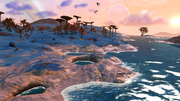
A narrow beach with tide pools.
The standard terrain - that is, terrain which is not underwater or underground - of New Lennon is composed of islands of various sizes. Some are too small to land a starship on, while others could host several massive bases and still have space left over. They also vary in that some have fairly large mountain peaks, while others are more flat, while others still (mostly small islands) may be perfectly flat.
Islands are rarely solitary, usually forming archipelagos, or chains of islands. The closest thing to "continents" on New Lennon are areas where the terrain occupies more space than the water and the islands are spaced closely enough that water bodies are closer to rivers than seas. There are no large, truly-unbroken landmasses.
Most islands are covered in fauna and at least some flora, but others, particularly small-to-medium-sized islands which do not rise high above sea level, may be devoid of both. Sandbars are also common. On larger islands, beaches can be found where the water meets the land. Most beaches are a mixture of sandy and rocky terrain.
Subterranean[ | ]
Caves on New Lennon are usually approximately large enough to drive a Roamer or Colossus exocraft through, if they can fit through the often-narrow cave entrances. Cave systems may run for considerable lengths and branch off in many directions, but entrances to caves are uncommon. Caves are mostly composed of long tunnels which occasionally connect to other tunnels in more open chambers. Caves frequently taper off into flooded portions which may have few, if any, air pockets. Cave divers are recommended to equip sufficient Underwater Oxygen Upgrades and bring well-charged Terrain Manipulators.
As is true of most caves, bioluminescent Marrow Bulb flowers and Cobalt stalagmites are the primary features aside from occasional subterranean fauna. As cave entrances are uncommon, interlopers seeking caves to explore may have the most luck locating caves by searching for "Subterranean Relic" (Vortex Cube) or "Hazardous Flora" markers with their Analysis Visor. Note that Hazardous Flora markers will also appear above ground on M. Quillmipium (Lianara Vines).
Planet-shaking steps from Jade Hood Diplos can often be felt even underground.
A family of I. Bumbleanoe in a cave chamber located at Starbulb Lagoon (see Notable Locations & Waypoints)
Aquatic[ | ]
Oceans on this planet are somewhat shallow compared to the deepest possible oceans. Landmasses may enclose bodies of water in various ways, forming lakes, lagoons, (non-flowing) rivers, bays, and gulfs. Large, mostly-island-free oceans are also found on this planet.
Aside from observing aquatic flora & fauna and photographing underwater landscapes, aquatic cave diving is one popular activity in New Lennon's waters. It is also likely the most dangerous single-player activity on the planet. As mentioned above, underwater caves may go long periods without air pockets. To avoid drowning, cave divers are strongly advised to equip sufficient Underwater Oxygen Upgrade modules and bring fully-charged Terrain Manipulators. To access depths even greater than what Oxygen modules will allow, Roamer (or Colossus) Exocrafts can provide a mobile air pocket.
Atmosphere & Climate[ | ]
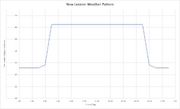
The weather pattern of New Lennon. No storms occur on this planet.
- Maximum Temperature: 22.5 °C
- Minimum Temperature: 15.2 °C
- Storm Temperature: N/A (No Storms)
- Radioactivity (Rad): 0.8
- Toxicity (Tox): 8.2
Notable Locations & Waypoints[ | ]
Player-made Content[ | ]
See New Lennon Base Catalog for individual player bases.
